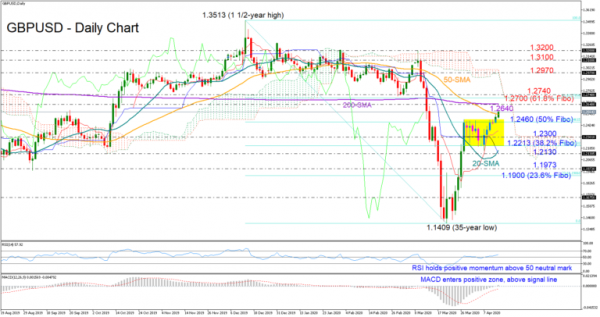GBPUSD terminated its range bound trading on Monday after the wall around the 1.2460 level, which is also the 50% Fibonacci of the downleg from 1.3513 to 1.1409, collapsed, giving the lead to the bulls.
Subsequently, the price strengthened towards the 50-day moving average (SMA) which is currently under examination, with the momentum indicators suggesting that the battle at this point may be an easy one. The RSI is holding a positive slope above its 50-neutral mark, the red Tenkan-sen line is deviating above the blue Kijun-sen, and the MACD is rising within the positive area for the first time since the start of the year.
Still, to convince traders over a more sustainable rally, the pair needs to breach the block between the 200-day SMA and the 1.2740 former support level as well. The 61.8% Fibonacci is also in the neighborhood adding extra importance to the area. A closing price above that zone could trigger another bullish session, driving the price probably up to 1.2970. Higher, the medium-term picture would shift back to neutral and the door would open for the 1.3100 and 1.3200 resistance levels. Yet, the bearish cross created between the 50- and the 200-day SMAs is casting doubts on whether the medium-term picture could improve.
On the downside, a drop below 1.2460 could be enough to bring the supportive red Tenkan-sen at 1.2368 and the 1.2300 barrier back into focus. Running lower, sellers will push harder to clear the base around the 38.2% Fibonacci of 1.2213 and stretch to 1.2130, where any violation could stage a sharper decline towards the 1.1973 number and the 23.6% Fibonacci of 1.1900, eliminating hopes of an upward-trending market.
In brief, GBPUSD is likely to gain new bullish steam in the short-term, though some congestion within the 1.2640-1.2700 zone is possible. In the medium-term, traders would upgrade their bearish outlook to neutral if the price manages to climb above 1.2960.













